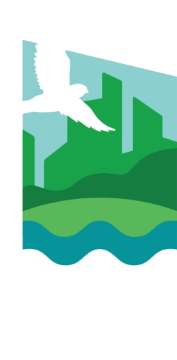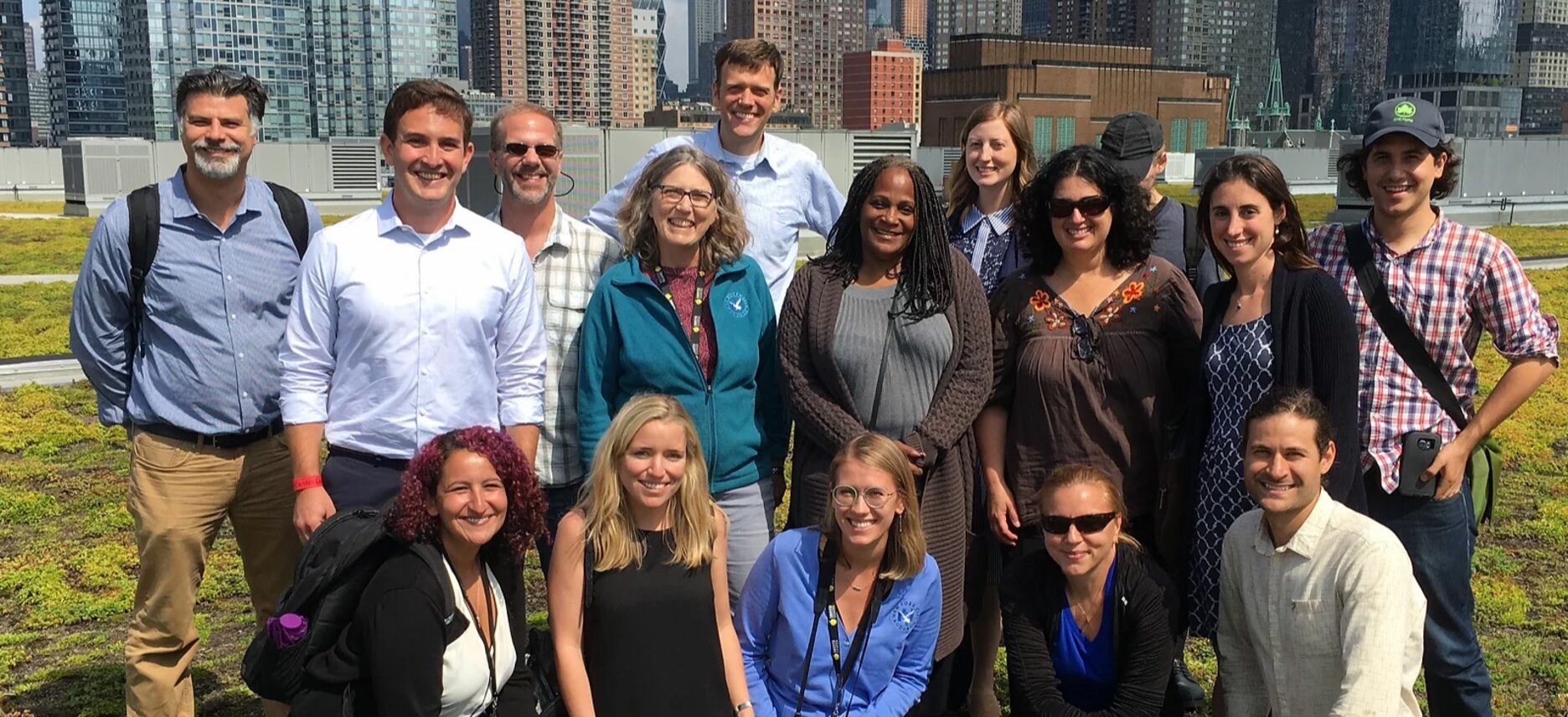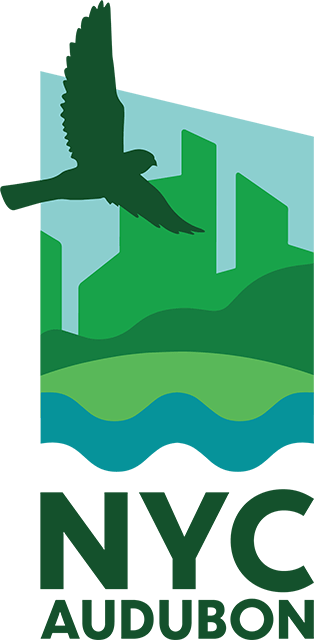Green Roofs and Infrastructure
Herring Gull eggs on the Jacob K. Javits Convention Center Green Roof. Photo: Jacob K. Javits Convention Center
Historically, NYC Audubon has advocated for the conservation of natural areas in New York City with two primary goals in mind: the preservation of habitat for birds, and the safeguarding of ecological services that protect both people and wildlife in our city. Projects such as Buffer the Bay (1987), Buffer the Bay Revisited (1993), and Jamaica Bay Coastal Habitat Restoration Project (1994-1996) aimed to protect land surrounding Jamaica Bay as bird habitat, and as a buffer from storms and flooding.
Protecting and preserving coastal habitat remains a critical priority. In recent years, as the need to protect the City has become ever more imperative in the face of climate change, city planners have begun to design built infrastructure to mimic the ecosystem services provided by natural areas. As you will read below, efforts to directly preserve natural habitat and create green urban infrastructure are in fact complementary.
The Problem of Stormwater
The U.S. Environmental Protection Agency estimates that nationwide, 10 trillion gallons a year of untreated stormwater runs off roofs, roads, parking lots, and other paved surfaces, often combined with household sewage, into urban rivers and waterways. These Combined Sewer Overflows (CSOs) represent a serious, and with climate change, growing problem for our planet. In New York City alone, about 30 billion gallons of CSOs are discharged annually, when rainwater flows into our sewers and overwhelms the water treatment plants, resulting in untreated waste water being discharged directly into our waterways.
In addition to the clear threat to the health of humans and wildlife, there is also mounting evidence that elevated nitrogen levels in CSOs contribute to the rapid erosion of our salt marshes—which control shoreline erosion and provide temporary resting grounds for the thousands of weary birds that pass through our area during migration The regular overflow of raw sewage and runoff from paved surfaces is a serious threat to the health of the Jamaica Bay ecosystem. Learn more about water quality and stormwater issues in New York City.)

Locations of green roofs in New York City as of 2016. Photo: The Nature Conservancy and The New School’s Urban Systems Lab
Creating Solutions—and Habitat
New York City is trying to address CSOs through a variety of responses developed in part by its Department of Environmental Protection (DEP). “Gray” infrastructure—traditional solutions such as sewage treatment plants and storage tanks—are being updated or rebuilt with green alternatives—green roofs, rain barrels, rain gardens, permeable pavement, tree pits with below-grade water catchments, and bioswales that catch and store rainwater, preventing it from causing sewage overflow events.
These green infrastructure projects are usually designed with stormwater capture and management as a main priority, but they also provide countless other benefits to our urban ecosystem, including lowered temperatures, improved air quality, and reduced noise pollution. Though not a replacement for habitat lost to development, these projects may help preserve the City’s remaining salt marshes by reducing stormwater run-off. And they may provide new habitat that will enable birds and other wildlife to survive, and thrive, in our urban environment.
NYC Audubon has been involved in a number of green infrastructure projects, detailed below. This work is enriched by cooperative partnerships, and to this end we facilitate the Green Roof Researchers Alliance, a consortium of over 60 green roof researchers. In collaboration with Fordham University and the American Museum of Natural History, we conduct biodiversity monitoring of green infrastructure sites focused on birds, bats, and insects.
NYC Audubon has been involved in a number of green infrastructure projects, detailed below. This work is enriched by cooperative partnerships, and to this end we facilitate the Green Roof Researchers Alliance, a consortium of over 60 green roof researchers. In collaboration with Fordham University and the American Museum of Natural History, we conduct biodiversity monitoring of green infrastructure sites focused on birds, bats, and insects.
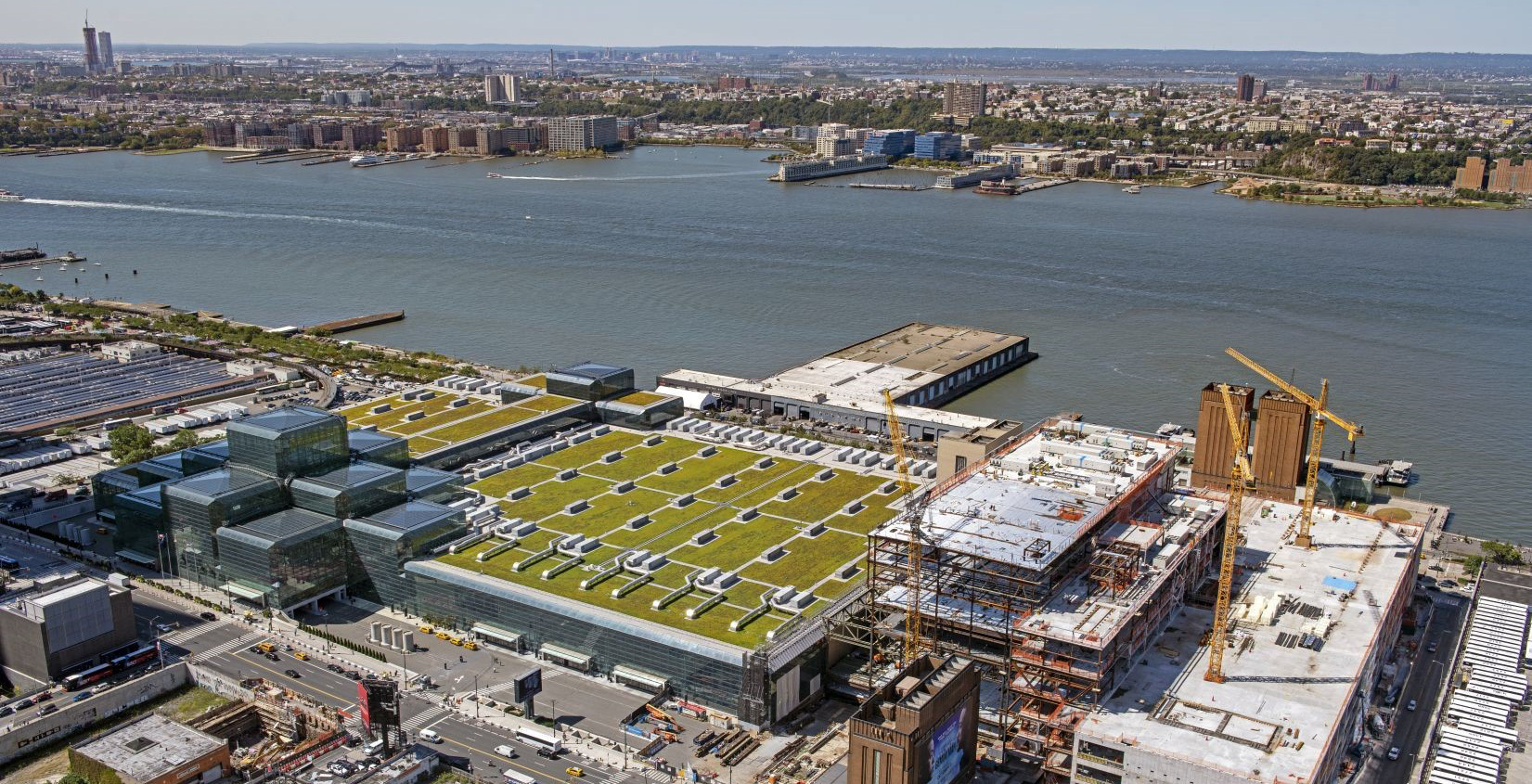
The 6.75-acre Jacob K. Javits Convention Center Green Roof. Photo: Jacob K. Javits Convention Center
Jacob K. Javits Convention Center Green Roof
High above the Westside Highway in Chelsea—one of Manhattan’s most relentlessly urban neighborhoods—birds, bats, and insects find habitat in a 6.75-acre expanse of sedum. The Jacob K. Javits Convention Center green roof was completed in 2014 as part of a milestone bird-friendly renovation of the Javits Center by architecture firms FXCollaborative and Epstein. Read more about the Javits Center’s bird-friendly renovation.
The Javits Center green roof, the largest in New York City, can absorb up to seven million gallons of stormwater runoff each year, helps reduce the Javits Center’s energy consumption (a total decrease of 26 percent), and extends the life of the roof. The Javits Center has welcomed NYC Audubon’s ongoing monitoring research, and is also a research site for many institutions studying the environmental effects of green roofs.
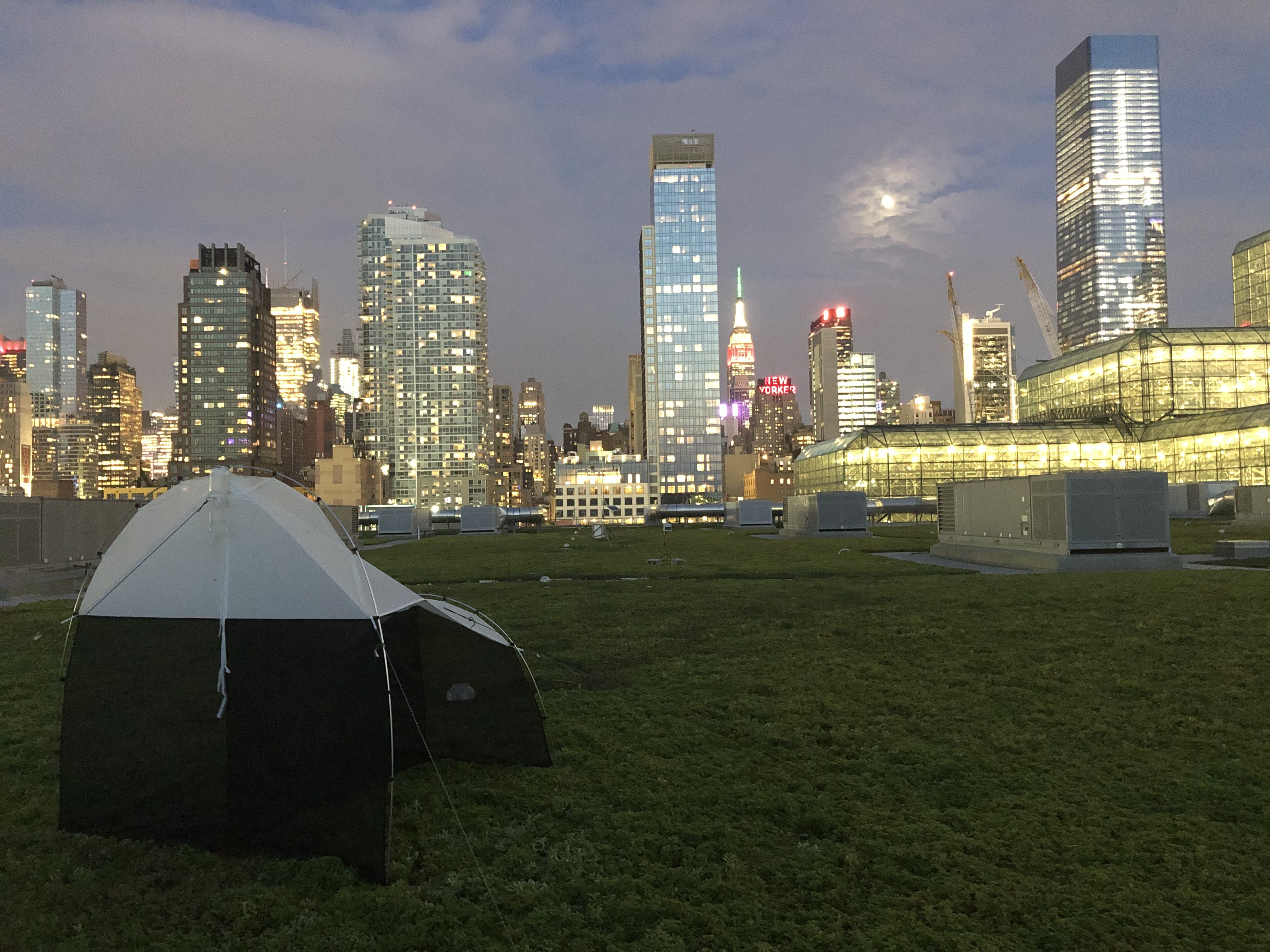
Sampling night flying arthropods to assess bat prey abundance on the Jacob K. Javits Convention Center Green Roof. Photo: NYC Audubon
Wildlife Monitoring
New York City Audubon began monitoring wildlife use of the newly installed Jacob K. Javits Center green roof in 2014. Our long-term dataset has begun to tell the story of how green roof biodiversity develops and changes in the years following installation. Birds are monitored using visual surveys, acoustic recording, and camera traps. Echolocation recording devices are used to monitor bat activity over the roof, and arthropods are collected in various types of traps during both the day and night.
We have tallied 65 bird species, 5 bat species, and representatives of 18 orders of arthropods, including 19 native bee species and 11 native butterfly species.
In early 2020, our green roof wildlife monitoring program added to the science of green roof ecosystems with research published in the journal Northeastern Naturalist. Analysis of insect and bat acoustic survey data from the Javits Center green roof showed that bat activity correlates with moth abundance on the roof. The findings suggest that urban green roofs provide wildlife habitat, and that bats forage on urban green roofs when their preferred prey (moths) are present. To request a PDF copy of the study, write Green Roof Program Manager and Ecologist Dustin Partridge, PhD, at dpartridge@nycaudubon.org.
In early 2020, our green roof wildlife monitoring program added to the science of green roof ecosystems with research published in the journal Northeastern Naturalist. Analysis of insect and bat acoustic survey data from the Javits Center green roof showed that bat activity correlates with moth abundance on the roof. The findings suggest that urban green roofs provide wildlife habitat, and that bats forage on urban green roofs when their preferred prey (moths) are present. To request a PDF copy of the study, write Green Roof Program Manager and Ecologist Dustin Partridge, PhD, at dpartridge@nycaudubon.org.
Kingsland Wildflowers at Broadway Stages with blooming Tickseed. Photo: NYC Audubon
Kingsland Wildflowers at Broadway Stages Green Roof
Beginning in 2016, NYC Audubon partnered with Newtown Creek Alliance, Broadway Stages, and Alive Structures to create a series of green roofs at Kingsland Wildflowers in Greenpoint, Brooklyn. Located in a polluted industrial area next to Newtown Creek, these roofs soak up stormwater, clean and cool the air, save energy costs, and provide much-needed habitat for birds, bats, and insects.
This three-year project managed by NYC Audubon was funded by the Greenpoint Community Environmental Fund, with matching support from building owner Broadway Stages, and was designed and built by local business Alive Structures. It includes just under 24,000 square feet of low-growing green roof and wildflower meadow planted with bird-friendly species native to the Long Island Sound coastal lowlands, including Butterfly Weed, Heart-leaved Golden Alexanders, and grasses such as Stout Blue-eyed Grass and Northern Dropseed.
Just as important, the community spaces were designed to be a tool to engage the public in conservation issues, environmental stewardship, and sustainability practices. A hands-on outdoor lab includes green roof space as well an additional 100 square feet of green wall. (View the [a href =” Green_roof_Teachers_Guide_web.pdf”]Green Roof Teachers Guide[/a] for grades pre-k through 5, created in collaboration with P.S. 41 Greenwich Village School, Alive Structures, and Newtown Creek Alliance.)
In July 2019, management of Kingsland Wildflowers at Broadway Stages transferred to Newtown Creek Alliance. Visit Kingsland Wildflowers at Broadway Stages to learn more about the project.

Pollination in Action on the Kingsland Wildflowers at Broadway Stages Green Roof. Photo: NYC Audubon
Wildlife Monitoring
NYC Audubon monitored wildlife at Kingsland Wildflowers from the spring of 2017 through July 2019. Wildlife richness quickly increased on the green roof, likely due to the diversity of native species included among the roof’s plantings. Within two years of its establishment, 17 arthropod orders, 20 bird species, and 5 bat species were recorded using the roof habitat. Pollinating native bees and flies visit the floral resources on the roof, while birds such as Barn Swallows and Chimney Swifts can be observed foraging overhead.
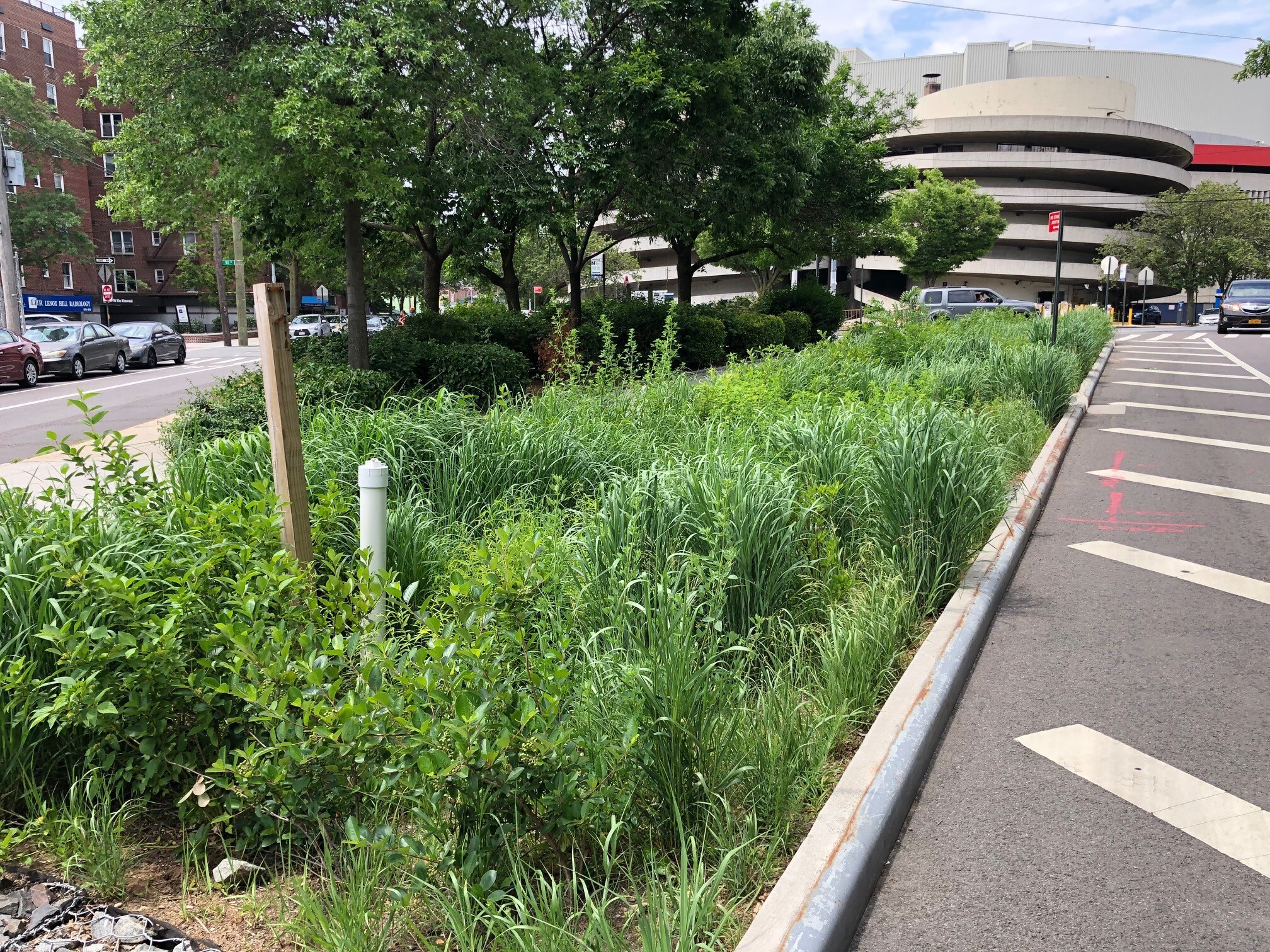
The Justice Avenue Bioswale incorporates native plants, mimicking natural conditions and flowering throughout the growing seasons, and provides benefits for pollinators, birds, and humans—all while capturing stormwater. Photo: NYC Audubon
Justice Avenue Stormwater Best Management Practices Pilot Project
In January 2011, the DEP inaugurated its Green Infrastructure Plan, which aims to improve water quality by integrating green infrastructure with gray infrastructure. The objective: to retrofit at least 10 percent of the impervious surfaces in the City’s combined sewer catchment areas, by 2030, to capture the first inch of runoff from every rainstorm and store it for later use/treatment or let it filter back into the ground to be taken up by plants or evaporated back into the atmosphere.
Starting in 2011, NYC Audubon launched a pilot project to replace a portion of Justice Avenue, in Elmhurst, Queens, with a bioswale to catch overflow and hold it until it is absorbed into the soil. With an initial design concept from landscape architecture firm SCAPE Studio, and engineering plans and oversight from design firm HDR, the bioswale was completed in 2018. It incorporates native plants, mimicking natural conditions and flowering throughout the growing season, and provides benefits for pollinators, birds, and humans—all while capturing stormwater.
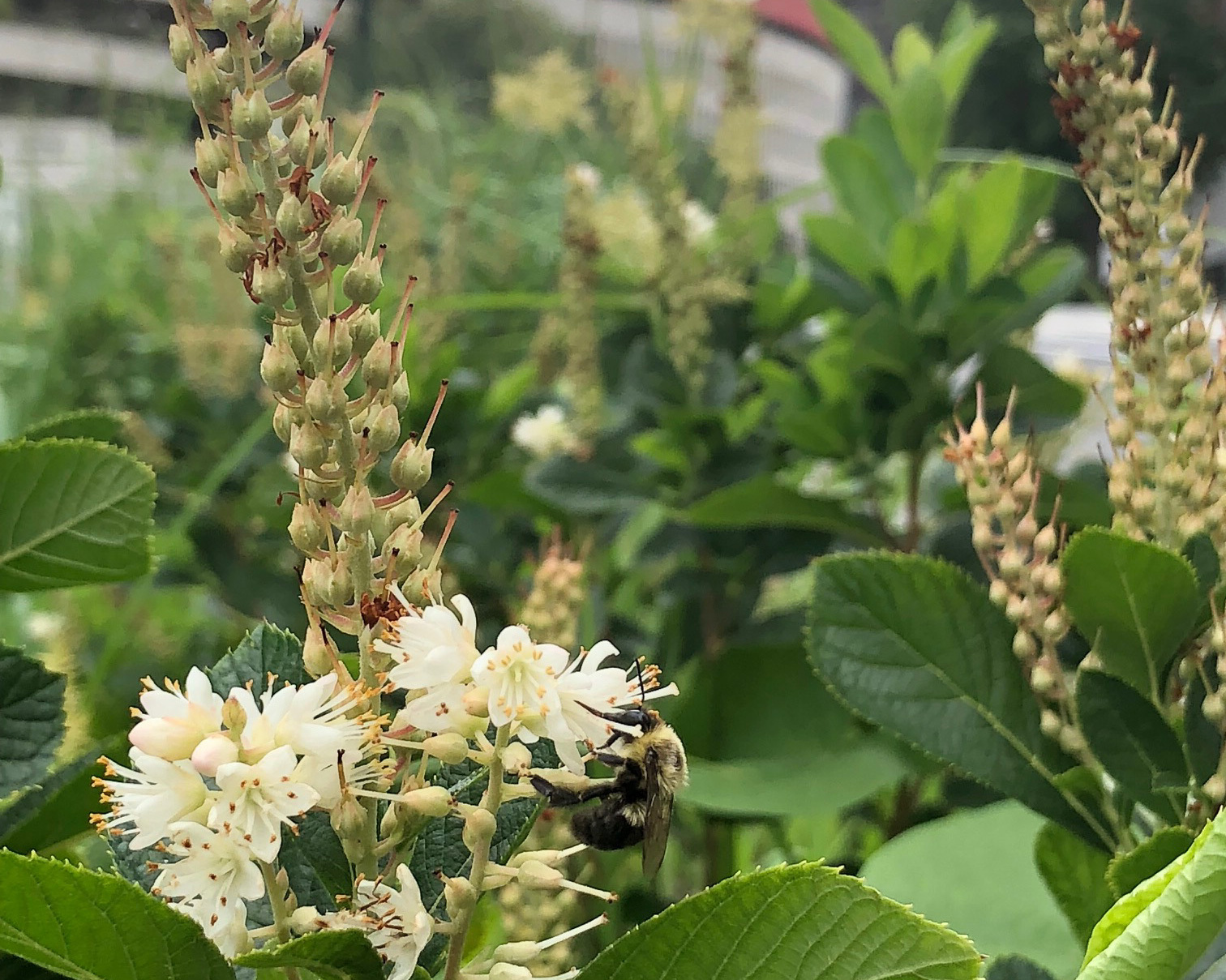
Sweet Pepperbush planted at Justice Avenue attracts pollinators such as bees. Photo: NYC Audubon
Wildlife Monitoring
In an effort to evaluate the benefits of the new bioswale for birds and other wildlife, NYC Audubon conducted bird and ground-dwelling arthropod surveys of the bioswale site at Justice Avenue before installation, and has continued this monitoring since its completion. The new bioswale was immediately colonized by arthropod wildlife, and has become a resource for local pollinators.
While the bioswale is a relatively small addition of green space, it has resulted in an increase in arthropod abundance and species richness in the adjacent park, providing more food for foraging birds. Only European Starlings and House Sparrows were observed in the park prior to the installation of the bioswale, but since its completion, Mourning Doves have also been observed.
 "}" data-trix-content-type="undefined" class="attachment attachment--content">
"}" data-trix-content-type="undefined" class="attachment attachment--content">Green Roof Researchers Alliance
Collaborative partnerships are of critical importance as we continue to support green infrastructure in New York City. With this in mind, NYC Audubon has facilitated creation of the Green Roof Researchers Alliance, a group of over 60 researchers in green roof science, policy, and education. Read more about the Green Roof Researchers Alliance.
HELP SPREAD GREEN ROOFS ACROSS THE CITY
The Green Roof Tax Abatement, which offers a $15 abatement for each square foot of green roof installed in environmentally vulnerable parts of the city, was reintroduced
for renewal in the New York State Legislature with significant improvements in 2022, but did not pass. These improvements would remove barriers to use, increase accessibility, and raise the baseline abatement from $5.23 to $10 for non-priority community districts. Call your state legislators (find them here) and ask them to re-introduce this bill!
for renewal in the New York State Legislature with significant improvements in 2022, but did not pass. These improvements would remove barriers to use, increase accessibility, and raise the baseline abatement from $5.23 to $10 for non-priority community districts. Call your state legislators (find them here) and ask them to re-introduce this bill!
